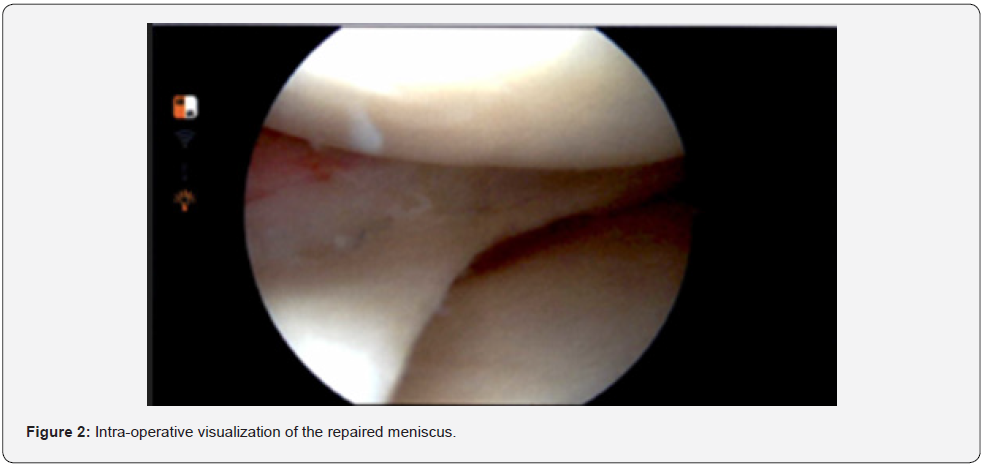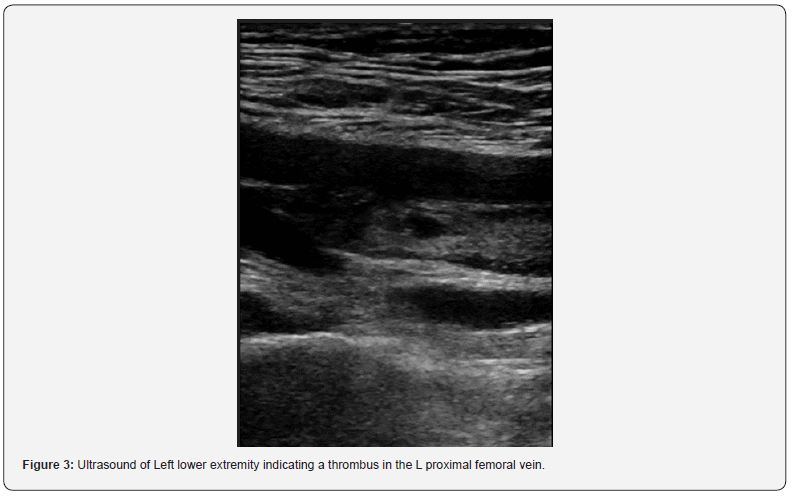Development of Post-Arthroscopic VTE during COVID-19 Pandemic in a Non-Thrombogenic Risk Factor Patient
Russell Russo R1*, Brennan Gioe W2 and Gianni Ly H2
1Department of Surgery and Orthopedics, New Orleans East Hospital, USA
2Department of Orthopedics, LSU Health Shreveport, USA
Submission: July 27, 2022;Published: August 08, 2022
*Corresponding author: Russell Russo, Department of Surgery and Orthopedics, New Orleans East Hospital, 6100 Pontchartrain Blvd New Orleans, LA 70124, USA
How to cite this article: Russell Russo R, Brennan Gioe W, Gianni Ly H. Development of Post-Arthroscopic VTE during COVID-19 Pandemic in a Non- Thrombogenic Risk Factor Patient. JOJ Orthoped Ortho Surg. 2022; 3(2): 555609.DOI: 10.19080/JOJOOS.2022.03.555609
Abstract
Data on the prevalence of venous thromboembolism (VTE), deep vein thrombosis (DVT), and pulmonary embolism (PE) in perioperatively infected Covid-19 patients is scarce. In this clinical case report, we present a rare incidence of a patient that contracted Covid-19 post left knee arthroscopy with medial meniscus repair (MMR) who subsequently developed a DVT with PE. This case report highlights a unique, new concern to current guidelines on DVT prophylaxis after arthroscopy in young, healthy adults. A previously healthy 37-year-old male presented with a bucket-handle tear of the left medial meniscus. A preoperative RT-PCR Covid-19 test was performed and revealed a negative COVID test, so we proceeded with a successful meniscus repair. The patient complained of shortness of breath and increasing left calf pain 8 days post-surgery despite remaining ambulatory in a postoperative brace. A new RT-PCR Covid-19 test was performed revealing a positive test for Covid-19. A left lower leg ultrasound and a CT of the chest were also performed the same day with findings of DVT and PE respectively. Recovery of the arthroscopic medial meniscus repair proceeded with no further complications, and symptoms from the DVT, PE resolved with treatment with mild residual symptoms. As Covid-19 and its variants continue to remain prevalent, information on the potential risk factors of the virus during postoperative care of arthroscopic procedures is increasingly important for both physicians and patients. This case presents the question should orthopedic surgeons routinely give chemoprophylaxis for outpatient arthroscopic cases in all patients?
Keywords: Venous thromboembolism; Pulmonary embolism; Prophylaxis; Meniscus repair; Chemoprophylaxis; Knee arthroscopy
Introduction
Recent literature has associated Covid-19 infection with abnormal coagulation characteristics [1]. Data on the prevalence of venous thromboembolism (VTE), deep vein thrombosis (DVT), and pulmonary embolism (PE) in Covid-19 patients is wide ranging and scarce. Previous literature has reported the weighted mean prevalence of VTE, DVT, and PE in Covid-19 patients to be 31.3%, 19.8%, and 18.9% respectively [2-4]. While knee arthroscopy is a widely used and generally safe procedure, data on the association of acute Covid-19 infection intraoperatively and increased risk of thromboembolism and DVT postoperatively is lacking [5,6]. The use of thromboprophylaxis in patients undergoing knee arthroscopy is controversial and often not indicated [7]. In this case report, we present a patient that underwent a left knee arthroscopy and developed a DVT with PE while acutely infected with Covid-19 post-operatively.
Case Report
On June 9, 2020, the 37-year-old male with no thrombogenic risk factors was playing Cabbage Ball and heard a pop while rounding 2nd base and noticed immediate swelling and decreased range of motion of his left knee. Patient underwent an MRI that day with findings of a bucket handle tear of left medial meniscus (Figure 1). On June 30th, the patient tested negative for SARS-CoV-2 (RT-PCR) in preparation for a left knee arthroscopy. On July 2nd the patient had a successful repair of bucket handle medial meniscus tear in less than 30 minutes operative time (Figure 2). Four days post-op, the patient called the clinic with a complaint of increasing left calf pain. Five days post-op, an ultrasound for DVT of left leg was performed with no indication of DVT. Ten days post-op, the patient called with recurring symptoms of increasing left calf pain alongside shortness of breath. A subsequent ultrasound of the left lower extremity revealed findings suggestive of DVT (Figure 3). Patient also underwent CT of the chest with findings indicating pulmonary embolism. Covid-19 test was administered upon entry through the ER and revealed acute Covid-19 infection. Eleven days post-op, the patient was admitted to the ICU for anticoagulation and further treatment. CRP, ESR, and WBC count revealed abnormally elevated levels. Three weeks post-op, a nurse scheduled daily virtual telehealth calls in which the patient denied any Covid-19 associated symptoms or other complaints. In clinic follow-up appointments on the fourth and eighth week postoperatively revealed no further complications, respectively.



Discussion
Deep vein thrombosis and venous thromboembolism are two of the most feared complications of arthroscopic surgery of the lower extremity. Chemoprophylaxis for DVT prevention in lowrisk patients undergoing knee arthroscopy (KA) is controversial. The risk for venous thromboembolism after a KA has been reported to range from 0.17% to 0.4% and would presumably be lower in non-risk factor patients such as the subject of this case report [5,6]. This minimal risk of thrombosis has to be weighed with the increased bleeding risk posed by chemoprophylaxis. Each patient’s risk for both thrombosis and bleeding are highly variable, so it is up to the physician to tailor his/her DVT prophylaxis based on each individual patient’s risk factors. Multiple studies show no clear reduction in thrombotic events with the use of chemoprophylaxis postoperatively, however in patients with risk factors for thrombogenesis, Aspirin therapy is commonly used in the non-weight bearing period [7-9]. In this case report, we present a previously healthy 37-year-old athletic male with no thrombogenic risk factors that developed a DVT and PE while acutely infected with Covid-19 postoperatively. In our practice, no chemoprophylaxis is given to “low risk” arthroscopy patients such as reported in this case. While the systemic effects of acute Covid-19 infection are not completely clear at this time, Covid-19 infection leading to increased risk for thrombogenesis has been documented in the literature. The cause of the high risk for vessel occlusion in Covid-19 patients is not completely identified at the moment but is suggested to be multifactorial. Acute inflammation caused by Covid-19 infection may promote thrombosis in multiple ways, including decreasing levels of circulating Protein C and antithrombin while increasing levels of plasminogen activator inhibitor-1 which ultimately leads to activation of the coagulation cascade and inhibition of fibrinolytic reaction [3]. A recent study suggests Covid-19 infection causes activation of antiphospholipid autoantibodies in many individuals, which may ultimately lead to the thrombosis of blood vessels [4]. It is our opinion that during times of prevalent Covid-19 infections no KA patients are in a “low risk” group for DVT development and chemoprophylaxis with aspirin should be standard protocol in each case.
Conclusion
In this case report, we present a patient that underwent a left knee arthroscopy and developed a DVT with PE while acutely infected with Covid-19 post-operatively. As our knowledge of Covid-19 its thrombogenic effects continue to evolve, we propose the standard protocol to include chemoprophylaxis for outpatient arthroscopic cases. We propose a DVT chemoprophylaxis of 81 mg Acetylsalicylic Acid PO b.i.d for arthroscopic surgeries until Covid-19 infections are comfortably low.
References
- Wu C, Chen X, Cai Y, Xia J, Zhou X, et al. (2020) Risk Factors Associated with Acute Respiratory Distress Syndrome and Death in Patients With Coronavirus Disease 2019 Pneumonia in Wuhan, China. JAMA Intern Med 180(7): 934-943.
- Di Minno A, Ambrosino P, Calcaterra I, Di Minno MND (2020) COVID-19 and Venous Thromboembolism: A Meta-analysis of Literature Studies. Semin Thromb Hemost 46(7): 763-771.
- Zhai Z, Li C, Chen Y, Wan J, Zhang Z, et al. (2020) Prevention and Treatment of Venous Thromboembolism Associated with Coronavirus Disease 2019 Infection: A Consensus Statement before Guidelines. Thromb Haemost 120(6): 937-948.
- Zuo Y, Estes SK, Ali Ra, Shi H, Sule G, et al. (2020) Prothrombotic autoantibodies in serum from patients hospitalized with COVID-19. Sci Transl Med 12(570): 3876.
- Maletis GB, Inacio MC, Reynolds S, Funahashi TT (2012) Incidence of symptomatic venous thromboembolism after elective knee arthroscopy. Bone Joint Surg Am 94(8): 714-720.
- Van Adrichem RA, Nemeth B, Algra A, et al. (2017) Thromboprophylaxis after knee arthroscopy and lower-leg casting. New England Journal of Medicine. 376(6): 515-525.
- Poitras V, Adcock L (2017) Acetylsalicylic Acid for Venous Thromboembolism Prophylaxis: Comparative Clinical Effectiveness and Guidelines. Ottawa (ON): Canadian Agency for Drugs and Technologies in Health.
- Perrotta C, Chahla J, Badariotti G, Ramos J (2020) Interventions for preventing venous thromboembolism in adults undergoing knee arthroscopy. Cochrane Database of Systematic Reviews Issue 5: CD005259.
- Lameire DL, Khalik HA, Phillips M, Banfield L, Peterson D, et al. (2022) Thromboprophylaxis after knee arthroscopy does not decrease the risk of deep vein thrombosis: a network meta-analysis. Knee Surg Sports Traumatol Arthrosc 30(7): 2364-2376.






























